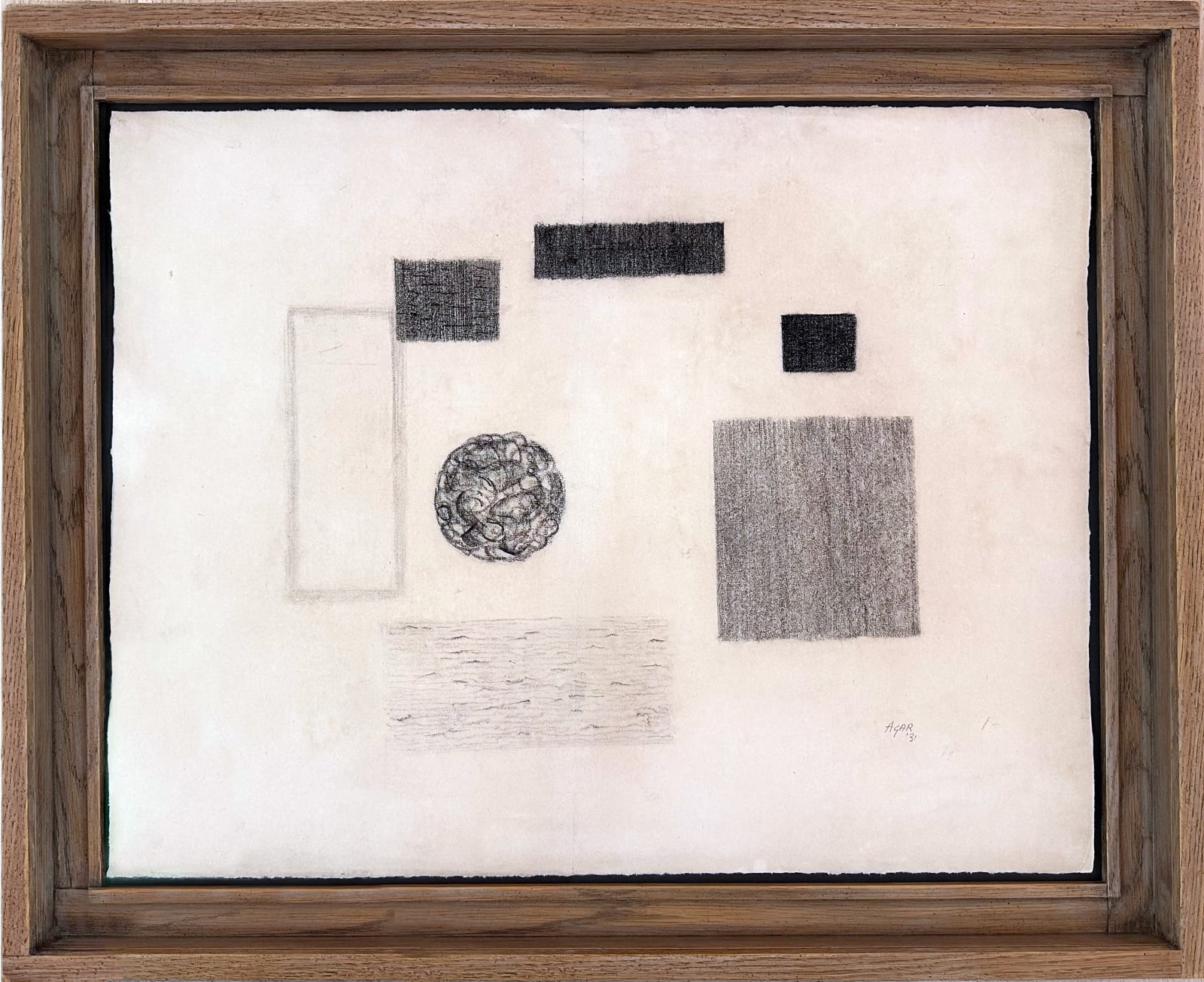Eileen Agar British, 1889-1991
Constructivist Composition, 1931
black crayon and pencil on paper
50 x 60 cm (framed)
Eileen Agar (b.1899 - d.1991, British) was an Argentine-British painter and photographer renowned for her contributions to the Surrealist movement. Born in Buenos Aires to a Scottish father and an...
Eileen Agar (b.1899 - d.1991, British) was an Argentine-British painter and photographer renowned for her contributions to the Surrealist movement. Born in Buenos Aires to a Scottish father and an American mother, Agar moved to England during her childhood. Encouraged by her teacher, Agar pursued her artistic education at institutions including the Byam Shaw School of Art and the Slade School of Fine Art.
In 1929, Agar relocated to Paris, immersing herself in the avant-garde scene and forming connections with prominent figures such as Paul Éluard, Ezra Pound, and André Breton. Agar’s innovative approach blended painting, collage, and found objects, leading to her inclusion in the 1936 International Surrealist Exhibition at London's New Burlington Galleries—the sole British woman to be featured. This milestone propelled her international reputation, with her works showcased in Surrealist exhibitions across Amsterdam, New York, Paris, and Tokyo by 1940.
Following the Second World War, Agar's prolific output was highlighted by sixteen solo exhibitions between 1946 and 1985. Agar’s distinctive pieces, such as ‘Angel of Anarchy’ (1940), exemplify her creative fusion of materials and themes. In recognition of her significant influence on Surrealism, Agar was elected as a Royal Academy Associate in 1990. Agar's legacy endures, with her works held in esteemed collections, including the Tate.
‘Constructivist Composition’ was part of Whitechapel Gallery’s touring exhibition Eileen Agar: Angel of Anarchy. The exhibition catalogue states: ‘Constructivist Composition is perhaps one of Agar’s most purely abstract works. The influence of the tutelage that Agar received from Foltýn – who taught her ‘about sensitivity to form while trying to cultivate colour, planes and composition’ – is particularly clear in the work’s palette of blacks, whites and greys, as well as its taut composition. The work also reveals Agar’s curiosity for organic shapes and variations of natural textures. ‘Constructivist Composition’ is a rare and early work that demonstrates Agar’s involvement and interest in the British abstract movement in the 1930s.’
‘Constructivist Composition’ was in the collection of Alexander Postan prior to being acquired by Gillian Jason Gallery. Agar’s work is currently in the collections of the Tate in the UK, the Metropolitan Museum of Art (New York), the Royal Academy of Arts (London), the Arts Council Collection (Southbank Centre) (London), the Hepworth Wakefield (Yorkshire), the National Galleries of Scotland (Edinburgh), and the Ingram Collection of Modern British and Contemporary Art (London).
In 1929, Agar relocated to Paris, immersing herself in the avant-garde scene and forming connections with prominent figures such as Paul Éluard, Ezra Pound, and André Breton. Agar’s innovative approach blended painting, collage, and found objects, leading to her inclusion in the 1936 International Surrealist Exhibition at London's New Burlington Galleries—the sole British woman to be featured. This milestone propelled her international reputation, with her works showcased in Surrealist exhibitions across Amsterdam, New York, Paris, and Tokyo by 1940.
Following the Second World War, Agar's prolific output was highlighted by sixteen solo exhibitions between 1946 and 1985. Agar’s distinctive pieces, such as ‘Angel of Anarchy’ (1940), exemplify her creative fusion of materials and themes. In recognition of her significant influence on Surrealism, Agar was elected as a Royal Academy Associate in 1990. Agar's legacy endures, with her works held in esteemed collections, including the Tate.
‘Constructivist Composition’ was part of Whitechapel Gallery’s touring exhibition Eileen Agar: Angel of Anarchy. The exhibition catalogue states: ‘Constructivist Composition is perhaps one of Agar’s most purely abstract works. The influence of the tutelage that Agar received from Foltýn – who taught her ‘about sensitivity to form while trying to cultivate colour, planes and composition’ – is particularly clear in the work’s palette of blacks, whites and greys, as well as its taut composition. The work also reveals Agar’s curiosity for organic shapes and variations of natural textures. ‘Constructivist Composition’ is a rare and early work that demonstrates Agar’s involvement and interest in the British abstract movement in the 1930s.’
‘Constructivist Composition’ was in the collection of Alexander Postan prior to being acquired by Gillian Jason Gallery. Agar’s work is currently in the collections of the Tate in the UK, the Metropolitan Museum of Art (New York), the Royal Academy of Arts (London), the Arts Council Collection (Southbank Centre) (London), the Hepworth Wakefield (Yorkshire), the National Galleries of Scotland (Edinburgh), and the Ingram Collection of Modern British and Contemporary Art (London).
Provenance
Artist Estate,Alexander Postan
Gillian Jason Gallery, 2019
Exhibitions
'Eileen Agar: Angel of Anarchy', 19 May – 29 August 2021, Whitechapel Gallery, London, UK'Eileen Agar: Angel of Anarchy', 25 September 2021 – 9 January 2022, Mjellby Konstmuseum, Halmstad, Sweden
'Eileen Agar: Angel of Anarchy', 29 January - 07 May 2022, Leeds Art Gallery, Leeds, UK



